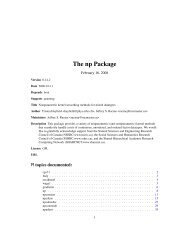The rgl Package - NexTag Supports Open Source Initiatives
The rgl Package - NexTag Supports Open Source Initiatives
The rgl Package - NexTag Supports Open Source Initiatives
Create successful ePaper yourself
Turn your PDF publications into a flip-book with our unique Google optimized e-Paper software.
18 matrices<br />
Details<br />
Value<br />
<strong>Open</strong>GL uses homogeneous coordinates to handle perspective and affine transformations. <strong>The</strong> homogeneous<br />
point (x, y, z, w) corresponds to the Euclidean point (x/w, y/w, z/w). <strong>The</strong><br />
matrices produced by the functions scaleMatrix, translationMatrix, and rotationMatrix<br />
are to be left-multiplied by a row vector of homogeneous coordinates; alternatively, the transpose<br />
of the result can be right-multiplied by a column vector. <strong>The</strong> generic functions scale3d,<br />
translate3d and rotate3d apply these transformations to the obj argument. <strong>The</strong> transform3d<br />
function is a synonym for rotate3d(obj, matrix=matrix).<br />
By default, it is assumed that obj is a row vector (or a matrix of row vectors) which will be<br />
multiplied on the right by the corresponding matrix, but users may write methods for these generics<br />
which operate differently. Methods are supplied for qmesh3d objects.<br />
To compose transformations, use matrix multiplication. <strong>The</strong> effect is to apply the matrix on the left<br />
first, followed by the one on the right.<br />
identityMatrix returns an identity matrix.<br />
scaleMatrix scales each coordinate by the given factor. In Euclidean coordinates, (u, v, w)<br />
is transformed to (x*u, y*v, z*w).<br />
translationMatrix translates each coordinate by the given translation, i.e. (u,v,w) is transformed<br />
to (u+x,v+y,w+z).<br />
rotationMatrix can be called in three ways. With arguments angle, x, y, z it represents<br />
a rotation of angle radians about the axis x, y, z. If matrix is a 3x3 rotation matrix, it will be<br />
converted into the corresponding matrix in 4x4 homogeneous coordinates. Finally, if a 4x4 matrix<br />
is given, it will be returned unchanged. (<strong>The</strong> latter behaviour is used to allow transform3d to<br />
act like a generic function, even though it is not.)<br />
Use asHomogeneous(x) to convert the Euclidean vector x to homogeneous coordinates, and<br />
asEuclidean(x) for the reverse transformation.<br />
identityMatrix, scaleMatrix, translationMatrix, and rotationMatrix produce<br />
a 4x4 matrix representing the requested transformation in homogeneous coordinates.<br />
scale3d, translate3d and rotate3d transform the object and produce a new object of the<br />
same class.<br />
Author(s)<br />
See Also<br />
Duncan Murdoch<br />
par3d for a description of how <strong>rgl</strong> uses matrices in rendering.<br />
Examples<br />
# A 90 degree rotation about the x axis:<br />
rotationMatrix(pi/2, 1, 0, 0)

















